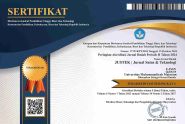Phytochemichal identification of Gayo tobacco or bakong Gayo (Nicotiana tabacum L) and its potency for industrial applications
Abstract
Abstract: This research aims to identify the phytochemical content of Gayo tobacco or Bakong Gayo (Nicotiana tabacum L) using Gas Chromatography Mass Spectrometry (GCMS) and its potential application in industry. Gayo tobacco was extracted using methanol solvent and characterized by GCMS using mode selection ion monitoring (SIM) which obtained twelve phytochemical contents in Gayo tobacco, were alkaloid, terpenoids, fatty acids and carbocyclic acid with the main compound being nicotine (40.58 %) and 4,8,13-duvatriene-1,3-diol (31.10 %). The twelve compounds identified can be applied as anticancer, insecticide, anti-depressant, sedative, anti-corrosion, aromatherapy and others based on the theory . All phytochemical compounds in Gayo tobacco allow it to be developed in the pharmaceutical and cosmetic industries.
Abstrak: Penelitian ini bertujuan mengidentifikasi kandungan fitokimia tembakau Gayo atau bakong Gayo (Nicotiana tabacum L) menggunakan Gas Chromatography Mass Spectrometry (GCMS) dan potensi apilkasinya diindustri. Tembakau Gayo diekstraksi dengan pelarut metanol dan ekstrak daun tembakau Gayo dikarakterisasi GCMS dengan menggunakan mode selected ion monitoring (SIM) diperoleh dua belas kandungan fitokimia dalam tembakau Gayo yaitu jenis alkaloid, terpenoid, asam lemak dan asam karbosiklik dengan senyawa utama yaitu nikotin sebesar 40,58% dan 4,8,13-Duvatriene-1,3-Diol sebesar 31,10 %. Kedua belas senyawa-senyawa yang diidentifikasi menurut teori dapat diaplikasi sebagai antikanker, insektisida, anti depresant, obat penenang, anti korosi, aromaterafi dan lain-lain. Semua senyawa fitokimia dalam tembakau Gayo memungkinkan untuk dikembangkan dalam bidang industri obat dan kosmetika.
Keywords
Full Text:
PDFReferences
Aji, Amri, Leni Maulinda, and Sayed Amin. 2015. “Isolasi Nikotin Dari Puntung Rokok Sebagai Insektisida.” Jurnal Teknologi Kimia Unimal 4(1): 100–120. http://ft.unimal.ac.id/teknik_kimia/jurnal.
Al-Edan, Ali Kadhim et al. 2023. “Palmitic Acid-Based Amide as a Corrosion Inhibitor for Mild Steel in 1M HCl.” Heliyon 9(4): e14657. https://doi.org/10.1016/j.heliyon.2023.e14657.
Bhalla, Nitesh, Nitin Ingle, Srilakshmi V. Patri, and D. Haranath. 2021. “Phytochemical Analysis of Moringa Oleifera Leaves Extracts by GC-MS and Free Radical Scavenging Potency for Industrial Applications.” Saudi Journal of Biological Sciences 28(12): 6915–28. https://doi.org/10.1016/j.sjbs.2021.07.075.
Chen, Yi et al. 2021. “Chromatographic Profiling with Machine Learning Discriminates the Maturity Grades of Nicotiana Tabacum l. Leaves.” Separations 8(1): 1–19.
Fan, Xing et al. 2022. “Analysis and Application Evaluation of the Flavour-Precursor and Volatile-Aroma-Component Differences between Waste Tobacco Stems.” Heliyon 8(9): e10658. https://doi.org/10.1016/j.heliyon.2022.e10658.
Folayan, Adewale Johnson, Paul Apeye Lucky Anawe, Adeyemi Emman Aladejare, and Augustine Omoniyi Ayeni. 2019. “Experimental Investigation of the Effect of Fatty Acids Configuration, Chain Length, Branching and Degree of Unsaturation on Biodiesel Fuel Properties Obtained from Lauric Oils, High-Oleic and High-Linoleic Vegetable Oil Biomass.” Energy Reports 5: 793–806. https://doi.org/10.1016/j.egyr.2019.06.013.
Gonzalez-Rivera, Maria L. et al. 2023. “In Vivo Neuropharmacological Effects of Neophytadiene.” Molecules 28(8): 1–12.
Handoyo, M. Ongky Muji, Yuliani Yuliani, and Erlix Rakhmad Purnama. 2022. “Uji in Silico Senyawa Phytol Hasil Ekstrak Daun Zodia (Evodiasuaveolens) Sebagai Antikanker.” Berkala Ilmiah Pendidikan Biologi (BioEdu) 11(2): 368–73.
Ishizaka, Nobuyuki et al. 1969. “Biological Activities of Rishitin, an Antifungal Compound Isolated from Diseased Potato Tubers, and Its Derivatives.” Plant and Cell Physiology 10(1): 183–92.
Ji, Huihua, Ying Wu, Franklin Fannin, and Lowell Bush. 2019. “Determination of Tobacco Alkaloid Enantiomers Using Reversed Phase UPLC/MS/MS.” Heliyon 5(5): e01719. https://doi.org/10.1016/j.heliyon.2019.e01719.
Jóźwiak, Michał et al. 2019. “Anticancer Effects of Alloxanthoxyletin and Fatty Acids Esters – In Vitro Study on Cancer HTB-140 and A549 Cells.” Biomedicine and Pharmacotherapy 110(September 2018): 618–30.
Li, Mingzhuo et al. 2022. “A de Novo Regulation Design Shows an Effectiveness in Altering Plant Secondary Metabolism.” Journal of Advanced Research 37: 43–60. https://doi.org/10.1016/j.jare.2021.06.017.
Pottier, Mathieu et al. 2020. “Identification of Two New Trichome-Specific Promoters of Nicotiana Tabacum.” Planta 251(3): 1–10. https://doi.org/10.1007/s00425-020-03347-9.
Schwingel, Liege C. et al. 2014. “3-O-Methylquercetin from Organic Nicotiana Tabacum L. Trichomes: Influence of the Variety, Cultivation and Extraction Parameters.” Industrial Crops and Products 55: 56–62. http://dx.doi.org/10.1016/j.indcrop.2014.01.054.
Shi, Haoqi et al. 2022. “Metabolomic and Transcriptomic Analysis of Roots of Tobacco Varieties Resistant and Susceptible to Bacterial Wilt.” Genomics 114(5): 110471. https://doi.org/10.1016/j.ygeno.2022.110471.
Sui, Xueyi et al. 2019. “Ethylene Response Factor NtERF91 Positively Regulates Alkaloid Accumulations in Tobacco (Nicotiana Tabacum L.).” Biochemical and Biophysical Research Communications 517(1): 164–71. https://doi.org/10.1016/j.bbrc.2019.07.037.
Weng, Weidong et al. 2023. “Tobacco Heating System Has Less Impact on Bone Metabolism than Cigarette Smoke.” Food and Chemical Toxicology 173(February 2022): 113637. https://doi.org/10.1016/j.fct.2023.113637.
Wong, Fong Fei et al. 2023. “A Preliminary Investigation of China Ginger and Kuching Local Ginger Species: Oil Extracts and Synthesis towards Potential Greener Insect Repellent.” Journal of Natural Pesticide Research 6(October): 100061. https://doi.org/10.1016/j.napere.2023.100061.
Yang, Cai Yan et al. 2018. “Nicotabaflavonoidglycoside, the First Example of Cembranoid and Flavonoid Heterodimer from Nicotiana Tabacum.” Fitoterapia 128(April): 242–46.
Yang, Chen et al. 2021. “Chemical Constituents from Nicotiana Tabacum L. and Their Antifungal Activity.” Natural Product Communications 16(11): 1–5.
Yang, Pei Song et al. 2019. “Three New Sesquiterpenes from the Stems of Nicotiana Tabacum and Their Bioactivities.” Journal of Asian Natural Products Research 21(2): 109–16. http://doi.org/10.1080/10286020.2017.1408597.
Zou, Xinda et al. 2021. “Current Advances of Functional Phytochemicals in Nicotiana Plant and Related Potential Value of Tobacco Processing Waste: A Review.” Biomedicine and Pharmacotherapy 143(August): 112191. https://doi.org/10.1016/j.biopha.2021.112191.
DOI: https://doi.org/10.31764/justek.v6i4.20331
Refbacks
- There are currently no refbacks.
JUSTEK : Jurnal Sains dan Teknologi sudah terindeks
EDITORIAL OFFICE:












.JPG)

